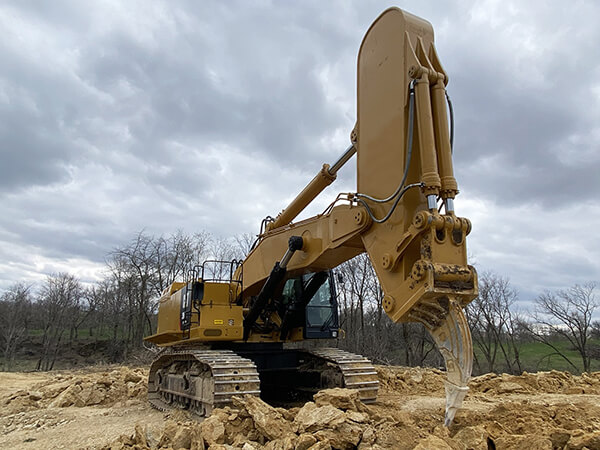In the vast world of engineering and construction, the JCB excavator ripper arm stands tall as an essential tool. With its formidable strength and precision, this robust attachment plays a pivotal role in excavating and demolishing even the toughest materials. In this article, we delve into the inner workings of the excavator ripper arm, exploring its design, functionality, and the diverse applications that make it an indispensable asset in engineering projects worldwide.

Unleashing the Ripper Arm’s Might
The JCB excavator ripper arm, also known as a ripper or a rock breaker, is an attachment specifically designed for excavators. It is composed of a long, sturdy arm affixed to the excavator’s bucket or boom. At the end of the arm, a toothed ripper shank, similar to a gigantic claw, dominates the structure. The ripper arm’s primary purpose is to break up, loosen, or remove hard materials such as rock, concrete, asphalt, and frozen ground.
The Engineering Anatomy
Crafted from high-grade steel, the JCB excavator ripper arm is built to withstand extreme forces and harsh environments. The attachment connects to the excavator’s hydraulic system, enabling precise control over its movements. This hydraulic system grants the operator the ability to adjust the angle, depth, and force applied by the ripper arm, allowing for efficient and controlled penetration into the ground or material being excavated.
The ripper shank itself consists of sharp, replaceable teeth designed to penetrate the ground or material. These teeth can be customized according to the specific task at hand, varying in size, shape, and spacing. For example, narrow teeth are ideal for digging trenches or breaking apart hard ground, while wider teeth are better suited for demolishing concrete structures.
Versatility and Applications
The versatility of the JCB excavator ripper arm enables its application in a wide range of engineering projects. In road construction, it is used to break up asphalt and concrete surfaces, facilitating repairs and resurfacing. For mining operations, the ripper arm is indispensable in breaking and extracting minerals embedded in rock formations. In land clearing projects, it aids in uprooting tree stumps and clearing dense vegetation, preparing the terrain for construction. Additionally, the ripper arm finds use in pipeline installation, quarry operations, and foundation excavation, among other endeavors.
Precision and Efficiency
The excavator ripper arm’s ability to precisely target and break up tough materials is instrumental in enhancing project efficiency. Its focused force enables operators to achieve selective excavation, avoiding unnecessary disturbance to the surrounding environment. Furthermore, the ripper arm’s speed and power help expedite the excavation process, reducing project timelines and overall costs. By incorporating the ripper arm into engineering projects, contractors can maximize productivity while minimizing environmental impact.
Safety Considerations
While the excavator ripper arm is a formidable tool, safety precautions are of utmost importance. Operators undergo extensive training to ensure they understand the equipment’s capabilities and limitations. Adequate personal protective equipment, such as reinforced gloves, helmets, and steel-toed boots, is essential when operating the machinery. Proper inspection and maintenance of the ripper arm and excavator are vital to prevent accidents and ensure smooth operation.
Conclusion
In the realm of engineering, the JCB excavator ripper arm proves to be an invaluable asset, enabling efficient excavation and demolition. With its robust design, precise control, and versatility, it tackles even the most challenging materials with ease. As engineering projects continue to evolve, the role of the ripper arm remains prominent, enhancing productivity while promoting safety and sustainability. It is undeniable that this mighty attachment will continue to shape the landscape of construction and engineering endeavors for years to come.

Further Innovations and Advancements
As technology continues to advance, the excavator ripper arm is not immune to innovation. Engineers and manufacturers are constantly striving to improve the performance and efficiency of this indispensable attachment. For instance, some ripper arms now incorporate advanced sensors and automation systems, allowing for more precise control and reducing operator fatigue. Additionally, the integration of telematics and GPS technology enables real-time monitoring of the ripper arm’s usage, optimizing maintenance schedules and enhancing overall productivity. These advancements in excavator ripper arm technology continue to push the boundaries of what is possible in the field of engineering.
Environmental Considerations
In today’s era of heightened environmental awareness, the impact of engineering projects on ecosystems is a significant concern. However, the excavator ripper arm can contribute to environmentally conscious practices. By enabling selective excavation and precise material removal, the ripper arm minimizes unnecessary disturbance to surrounding habitats. Furthermore, the attachment’s power and efficiency help reduce the overall energy consumption of excavation processes, leading to a smaller carbon footprint. As sustainability becomes increasingly important, engineers and contractors are incorporating ripper arms into their projects to strike a balance between progress and ecological preservation.
The Future of JCB Excavator Ripper Arm
Looking ahead, the future of JCB excavator ripper arm is promising. As technology advances and engineering demands evolve, we can expect further refinements in ripper arm design, control systems, and material composition. The integration of artificial intelligence and machine learning algorithms may revolutionize the ripper arm’s capabilities, enabling autonomous excavation and adaptive performance. Additionally, the ongoing pursuit of lightweight yet robust materials will enhance efficiency and reduce energy consumption. With a growing emphasis on sustainability and precision, the excavator ripper arm will continue to be an essential tool in engineering, contributing to the development of more efficient, eco-friendly, and innovative construction practices.
In conclusion, the excavator ripper arm plays a powerful and indispensable role in engineering projects. Its robust design, precise control, and versatility enable the excavation and demolition of challenging materials, enhancing productivity and project efficiency. As technology advances, the ripper arm continues to evolve, incorporating advanced sensors, automation systems, and telematics to further optimize its performance. Moreover, with increasing environmental awareness, the ripper arm’s selective excavation capabilities contribute to sustainable practices. As we move forward, the future of excavator ripper arms holds great potential, with ongoing innovations shaping the landscape of construction and engineering for years to come.
